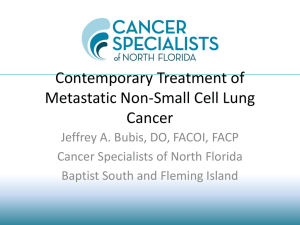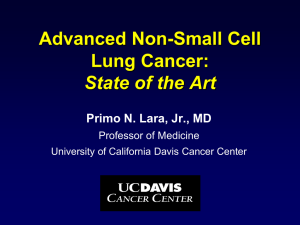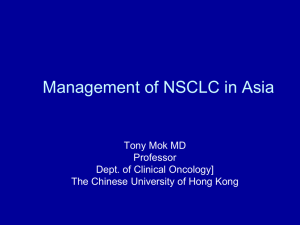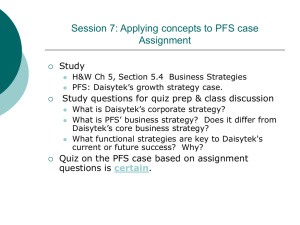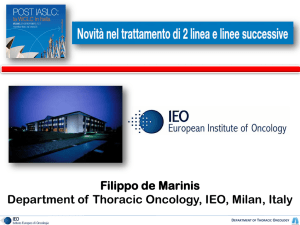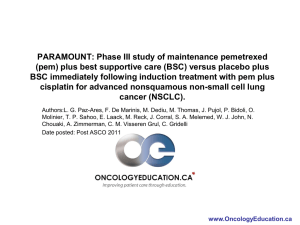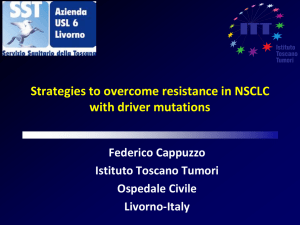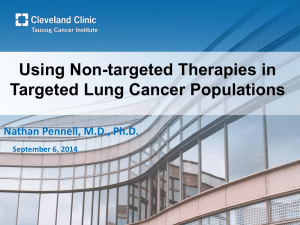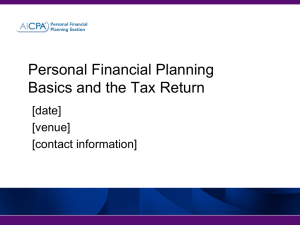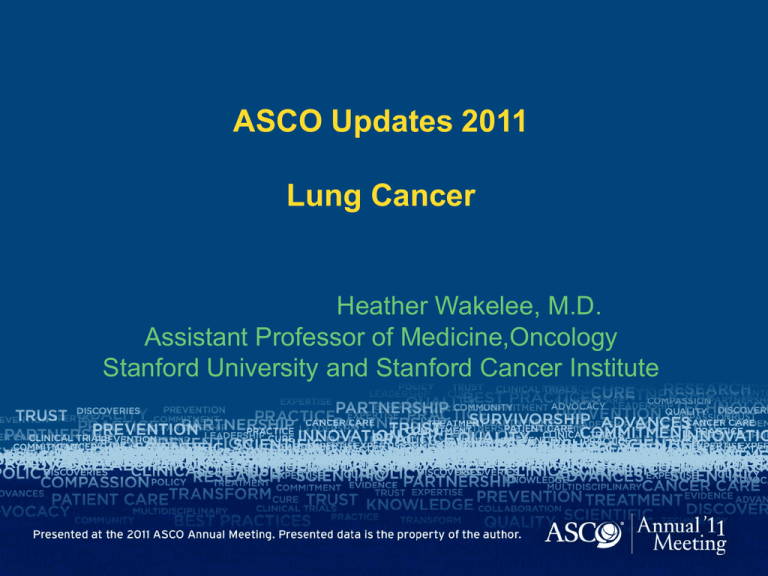
ASCO Updates 2011
Lung Cancer
Heather Wakelee, M.D.
Assistant Professor of Medicine,Oncology
Stanford University and Stanford Cancer Institute
Abstracts to be discussed
• Metastatic NSCLC
– Maintenance
• CRA7510 - pemetrexed, LBA7511 – gefitinib
– Targeted Therapy
• LBA7512- motesanib, 7502-vadimezan, CRA7506driver mutations, 7503- EURTAC, 7505- MetMab,
7507-crizotinib, 7500-ganetespib
• Early Stage NSCLC
• 7002-TREAT, 7013-E1505
• Small Cell Lung Cancer
• 7000-amrubicin
Abstracts to be discussed
• Metastatic NSCLC
– Maintenance
• CRA7510 - pemetrexed, LBA7511 - gefitinib
– Targeted Therapy
• LBA7512- motesanib, 7502-vadimezan, CRA7506driver mutations, 7503- EURTAC, 7505- MetMab,
7507-crizotinib, 7500-ganetespib
• Early Stage NSCLC
• 7002-TREAT, 7013-E1505
• Small Cell Lung Cancer
• 7000-amrubicin
Recent Maintenance Trials
• Docetaxel early vs. late
– PFS benefit
– Strong trend OS benefit
• Pemetrexed vs placebo
– PFS + OS benefit
• Erlotinib vs placebo - Saturn
– PFS + small OS benefit
• Erlotinib vs placebo + Bevacizumab (ATLAS) ~ early vs late (unblinding at PD)
– PFS benefit
– Trend OS benefit
Continuation Maintenance
•Study/Yr
Induction Maintenance
MTTP/MP
FS
Med OS
toxicity
Carbo/Ta
x
Paclitaxel wk
Obs
38 wk
29 wk
75 wk
60 wk
45% Gr 3/4
Brodowicz Cis/Gem
2006
Gem d1,8
Obs
6.6 mo
5.0 mo
P<.001
13 mo
11 mo
Heme tox
in 20%+
Belani
2010
Carbo/Ge
m
Gem d1,8
Obs
7.4 mo
7.7 mo
8 mo
9.3 mo
NS
<20%
Heme
Perol
2010
Cis/Gem
Gem d1,8
Obs
3.8 mo
1.9 mo
P<.001
NR
28% Gr 3/4
Belani
2003
Clear benefit of continuation in PFS in 3/4, and trend in OS in 2/3 trials
PFS matters if we will never return to the 1st line drugs which were stopped
Fidias/Novello JCO Dec 2010
Continuation Maintenance
• Bevacizumab, cetuximab, erlotinib are
ALWAYS given w/ maintenance approach
• Patel’s phase II study of
carboplatin/pemetrexed/bevacizumab w/
continuation of pem/bev was very
promising
• We never stop 2nd or 3rd line therapy while
it is working, so why do we stop 1st line?
PARAMOUNT: Phase III Study of
Maintenance Pemetrexed (Pem) Plus Best
Supportive Care (BSC) Versus Placebo Plus
BSC Immediately Following Induction
Treatment with Pem Plus Cisplatin for
Advanced Nonsquamous NSCLC
CRA 7510
L. G. Paz-Ares1, F. de Marinis2, M. Dediu3, M. Thomas4, J.L. Pujol5,
P. Bidoli6, O. Molinier7, T.P. Sahoo8, E. Laack9, M. Reck10, J. Corral1,
S. Melemed11, W. John11, N. Chouaki12, A. H. Zimmermann11,
C. Visseren-Grul13, C. Gridelli14
1
PARAMOUNT: Background
Pemetrexed is active nonsquamous NSCLC:
─ In first-line doublet 3
─ As maintenance agent following a non-pem platinum doublet 4
JMEN: after 4 cycles non-pem platinum doublet pem vs placebo
Non-squamous pt results: OS HR .07, p.002
Pemetrexed maintenance has not been studied following
pemetrexed-platinum induction in a phase III setting
(continuation maintenance)
Paz-Ares PASCO 2011, LBA7510
1
http://seer.cancer.gov/statfacts/html/lungb.html; 2Azzoli CG et al. J Clin Oncol 2009; 27:6251–6266 3Scagliotti GV et al.
J Clin Oncol 2008;26:3543-51.; 4Ciuleanu T et al. Lancet 2009;374:1432-40.
PARAMOUNT: Study Design
Paz-Ares PASCO 2011, LBA7510
Study Treatment Period
Progression
Induction Therapy (4 cycles)
Patients enrolled if:
• Nonsquamous NSCLC
• No prior systemic treatment for
lung cancer
• ECOG PS 0/1
500 mg/m2 Pemetrexed +
75 mg/m2 Cisplatin, d1, q21d
21 to 42 Days
Maintenance Therapy (Until PD)
500 mg/m2 Pemetrexed + BSC, d1, q21d
CR,
PR, SD
2:1 Randomization
Placebo + BSC, d1, q21d
Stratified for:
•PS (0 vs 1)
•Disease stage (IIIB vs IV) prior to induction
•Response to induction (CR/PR vs SD)
PD
Randomized, placebo-controlled, double-blind, phase III study
Folic acid and vitamin B12 administered to both arms
PARAMOUNT: Investigator Assessed PFS
(from Maintenance)
1.0
Pem + BSC
0.9
Placebo + BSC
0.8
SurvivalProbability
0.7
Pemetrexed: median =4.1 mos (3.2-4.6)
Placebo: median =2.8 mos (2.6-3.1)
Log-rank P=0.00006
Unadjusted HR: 0.62 (0.49-0.79)
0.6
0.5
Patients
0.4 at Risk
Pem + BSC
0.3
N=359
132
57
21
4
0
Placebo +
BSC
0.2
N=180
52
15
5
0
0
0.1
0.0
0
JMEN: PFS 4.4 mo vs 1.8 mo, HR 0.47, p<.00001
3
Paz-Ares PASCO 2011, LBA7510
6
9
Tim
e(M
onths)
12
15
Efficacy and tolerability data from a
randomized, placebo-controlled, parallel-group
study of gefitinib as maintenance therapy in
patients with locally advanced or metastatic
NSCLC (INFORM) (C-TONG 0804)
L Zhang, SL Ma, XQ Song, BH Han, Y Cheng, C Huang, SJ Yang, XQ Liu,
YP Liu, MZ Wang, XW Zhang on behalf of the INFORM investigators
# LBA 7511
INFORM: Study design
Zhang PASCO LBA7511
Endpoints
Patients
• Age
≥18 years
• Completed 4 cycles
of first-line platinumbased chemotherapy
without PD or
unacceptable toxicity
• Life expectancy
≥12 weeks
• WHO PS 0-2
• Measurable
Stage IIIB/IV disease
Primary
Gefitinib
(250 mg/day)
1:1 randomization
Placebo
(once daily)
EGFR, epidermal growth factor receptor; PD, progressive disease
PS, performance status; WHO, World Health Organization
• Progression-free survival (PFS)
Secondary
• Objective response rate (ORR)
• Disease control rate (DCR)
• Overall survival (OS)
• Quality of life
• Safety and tolerability
Exploratory
• Biomarkers
– EGFR mutation
INFORM: PFS (ITT population)
Zhang PASCO LBA7511
100
90
Probability of PFS (%)
80
Median PFS,† months
6-month PFS rate, %
12-month PFS rate, %
No. events, n (%)
70
60
Gefitinib
(n=148)
Placebo
(n=148)
4.8
47.3
33.2
124 (83.8)
2.6
15.0
2.9
144 (97.3)
HR‡ (95% CI) = 0.42 (0.33, 0.55); p<0.0001
50
40
30
20
10
0
0
8
16
24
32
40
48
56
64
72
80
88
96
2
15
0
6
104 112
Time since randomization (weeks)
Patients at risk :
Placebo 148 82
46 26
Gefitinib 148 109 82
70
†Estimated using the Kaplan-Meier method
‡Primary Cox analysis with covariates
16
65
10
56
6
49
4
42
3
38
2
31
2
20
0
1
0
0
INFORM PFS by EGFR mut status
Zhang PASCO LBA7511
EGFR mutation-positive
EGFR mutation-negative
Gefitinib (n=15) Median PFS†, 16.6 months
No. events, 9 (60.0%)
Placebo (n=15) Median PFS†, 2.8 months
No. events, 15 (100.0%)
Gefitinib (n=25) Median PFS†, 2.7 months
No. events, 25 (100.0%)
Placebo (n=24) Median PFS†, 1.5 months
No. events, 24 (100.0%)
HR (95% CI) = 0.17 (0.07, 0.42)
100
100
80
PFS (%)
PFS (%)
80
HR (95% CI) = 0.86 (0.48, 1.51)
60
40
20
60
40
20
0
0
0
8
16 24 32 40 48 56 64 72 80 88 96 104 112
Time (weeks)
No. of patients at risk
0
8
16 24 32 40 48 56 64 72 80 88 96 104 112
Time (weeks)
No. of patients at risk
Placebo 15
9
1
1
1
1
1
0
0
0
Placebo 24
9
5
3
2
0
0
0
0
0
0
0
0
0
0
Gefitinib 15 15 14 14 13 11 10 18
7
7
5
3
1
0
0
Gefitinib 25 14
6
3
3
1
0
0
0
0
0
0
0
0
0
†Estimated
5
3
3
2
1
using the Kaplan-Meier method
INFORM OS: (ITT population)
Gefitinib Placebo
(n=148) (n=148)
100
16.9
Median OS, months
18.7
84.9
6-month survival rate, % 82.2
66.0
12-month OS rate, %
68.8
No. events, n (%)
79 (53.4) 93 (62.8)
90
Overall survival (%)
80
70
HR (95% CI) = 0.84 (0.62, 1.14); p=0.2608
60
50
40
30
20
10
0
0
8
16 24
32 40 48 56
Patients at risk:
72 80
88
96 104 112 120 128
Time (weeks)
Placebo 148 147 136 127 115 107 97 91
Gefitinib 148 141 129 119 114 108 102 90
HR <1 implies a lower risk of death on gefitinib
64
78
84
66 47
75 56
37 13
39 18
6
4
0
0
0
0
0
0
Conclusions – Switch Maintenance
• PFS improved in ALL switch maintenance studies
• OS significantly improved w/ PEM in JMEN and
erlotinib in Saturn but not gefitinib in INFORM
• OS strongly trended in favor of early docetaxel
• Patients receiving delayed 2nd line Rx MAY live
just as long IF they receive the effective agent
• BUT we miss at least 1/3 of them
• 2nd line therapy works, we should not deny our
patients 2nd line therapy
Abstracts to be discussed
• Metastatic NSCLC
– Maintenance
• CRA7510 - pemetrexed, LBA7511 - gefitinib
– Targeted Therapy
• LBA7512- motesanib, 7502-vadimezan,CRA7506driver mutations, 7503- EURTAC, 7505- MetMab,
7507-crizotinib, 7500-ganetespib
• Early Stage NSCLC
• 7002-TREAT, 7013-E1505
• Small Cell Lung Cancer
• 7000-amrubicin, 7001-obatoclax
E4599: Bevacizumab Efficacy
RR: 15% for Carboplatin (CbP) vs 35% for CbP + Bevacizumab
PFS
Patients With PFS (%)
80
60
40
P < .001; HR: 0.66
Median PFS: 6.2 mos vs
4.5 mos
6-mos PFS: 55% vs 33%
1-yr PFS: 15% vs 6%
20
0
0
6
12
18
24
30
36
Mos
Sandler A, et al. N Engl J Med. 2006;355:2542-2550.
.
100
CbP
CbP + bevacizumab
CbP
CbP + bevacizumab
80
Patients Surviving (%)
100
OS
P = .003; HR: 0.79
Median OS: 12.3 mos vs
10.3 mos
1-yr OS: 51% vs 44%
2-yr OS: 23% vs 15%
60
40
20
0
0
6
Mos
12
18
24
30
36
Promising Small Molecule Inhibitors of
VEGFR and Their Targets
Inhibitor
VEGFR-1 VEGFR-2 VEGFR-3
PDGFR
cKIT
EGFR
Other
Sunitinib
+
+
-
+
+
-
FGFR
Valatanib
+
+
+
+
+
-
cFms
Vandetanib
-
+
+
+/-
-
+
ret
Cediranib
+
++
+
+
-
-
Pazopanib
+
+
+
Sorafenib
-
+
+
+
+
-
Axitinib
+
+
+
+
+
-
Cabozantinib
+
+
+
Motesanib
+
+
+
+
BIBW1120
+
+
+
+
-
+
Raf
Met
+
FGFR
VEGFR-TKI activity in NSCLC
• Vandetanib improved symptoms combination w/ 2nd line
chemo
– Improved PFS with docetaxel, but no FDA approval
• Cediranib with 1st line chemo promising (BR.24)
– Press release that phase III trial halted for toxicity
• Sorafenib single agent promising results, but toxic w/
carbo/taxol (ESCAPE trial)
An international, randomized, placebo-controlled, double-blind
phase III study (MONET1) of motesanib plus carboplatin/paclitaxel
(C/P) in patients with advanced nonsquamous non-small cell lung
cancer (NSCLC)
• 1090 chemo-naïve pts with stage IIIB/IV NSCLC
• Randomized to 6 cycles of carboplatin/paclitaxel
+ motesanib 125 mg QD (Arm A) or placebo QD (Arm B)
• OS was NOT significantly improved w/ motesanib
– 13 mo vs 11 mo, HR .9, p.14, primary endpoint
• PFS was improved w/motesanib
– HR .79, p.0006
• ORR was significantly improved with motesanib
– 40% vs 26%, p<.0001
• Incidence of grade 3 AEs in Arms +/- m was 73%/59%
Scagliotti LBA#7512
Aflibercept in combination with docetaxel for 2nd-line
treatment of locally advanced or metastatic NSCLC: Final
results of a multinational placebo-controlled phase III trial
(VITAL)
• Aflibercept novel fusion protein binding VEGF-A, -B and
PIGF acting as a decoy receptor
• 913 pts w/ stage IIIB/IV NSCLC s/p 1 prior chemo
– randomized to docetaxel + aflibercept or placebo
•
•
•
•
83% adenoCA, Med age 60 yo, 66% male
OS 10.4 vs 10.0 mo, HR 1.0 w aflibercept, primary endpoint
PFS HR .82, p.0035
RR 9% vs 23%, p<.0001
Novello, WCLC 2011, O43.06
Study Design
ASA404 (vadimezan): a small molecule vascular disrupting agent;
Causes breakdown of vasculature and hemorrhagic tumor necrosis
Randomization 1:1
• Stage IIIB/IV NSCLC
• All histologies
• First-line
chemotherapynaïve
N=1200
• PS 0 or 1
• Stratification:
• Sex
• Squamous vs
non-squamous
•
•
•
Lara abstr 7502
Paclitaxel + carboplatin +
ASA404
Paclitaxel + carboplatin +
placebo
Paclitaxel 200 mg/m2, carboplatin AUC 6, and
ASA404 1800 mg/m2 or placebo
Day 1, q3w, up to six cycles
ASA404 maintenance treatment (after
completion of six cycles of ASA404 + P/C up to
progression)
ATTRACT1: Overall Survival
Arm
Median
survival (95%
CI)
Lara abstr 7502
ASA404 + PC
Placebo + PC
13.4 months
(11.4, 16.6)
12.7 months
(11.3, 14.4)
Anti-Angiogensis in NSCLC
No biomarkers, small steps forward
• Bevacizumab increases RR and PFS when added to 1st line
chemotherapy for NSCLC, improved OS in 1/2 trials
• No VEGFR-TKI to date has improved the efficacy of
chemotherapy, including motesanib at ASCO 2011
• Decoy receptor-aflibercept – No OS benefit with chemotherapy
• Vascular disrupting agent ASA404 failed to improve outcomes
when added to chemotherapy
• Single agent promise seen with sorafenib, sunitinib, others, but
no confirmatory phase III trial data to date
• Novel agents in development – other VDAs, other antibodies
• Predictive and prognostic markers are in development to help
guide patient selection- but none validated to date
– ICAM, VEGF levels, VEGF polymorphisms, C/AFs…
Abstracts to be discussed
• Metastatic NSCLC
– Maintenance
• CRA7510 - pemetrexed, LBA7511 - gefitinib
– Targeted Therapy
• LBA7512- motesanib, 7502-vadimezan, CRA7506driver mutations, 7503- EURTAC, 7505- MetMab,
7507-crizotinib, 7500-ganetespib
• Early Stage NSCLC
• 7002-TREAT, 7013-E1505
• Small Cell Lung Cancer
• 7000-amrubicin, 7001-obatoclax
Lung Cancer Mutation
Consortium Kris ASCO 2011, CRA7506
Lung Cancer Mutation Consortium
Kris ASCO 2011, CRA7506
Number analyzed for mutation and FISH
Mutation
profiling
82
294
Total study group
as of 13 May 11
1064
FISH
516
172
Pending
analysis
Lung Cancer Mutation Consortium
Incidence of Single Driver Mutations
Mutation found in 54% (280/516) of
tumors completely tested (CI 50-59%)
Kris ASCO 2011, CRA7506
IPASS: Progression-free survival in EGFR
mutation + vs - patients
EGFR mutation-positive
Gefitinib (n=132)
Carboplatin/paclitaxel (n=129)
0.8
HR (95% CI) = 0.48 (0.36, 0.64)
p<0.0001
0.6
No. events gefitinib, 97 (73.5%)
No. events C/P, 111 (86.0%)
0.4
0.2
0.0
0
4
8
12
16
20
24
Gefitinib (n=91)
Carboplatin/paclitaxel (n=85)
1.0
Probability of progression-free survival
1.0
Probability of progression-free survival
EGFR mutation-negative
0.8
HR (95% CI) = 2.85 (2.05, 3.98)
p<0.0001
0.6
No. events gefitinib, 88 (96.7%)
No. events C/P, 70 (82.4%)
0.4
0.2
0.0
0
4
8
Months
At risk:
Gefitinib 132
C/P
129
108
103
71
37
31
7
12
16
20
24
1
0
0
0
0
0
Months
11
2
3
1
0
0
91
85
21
58
4
14
2
1
Treatment by subgroup interaction test, p<0.0001
Incidence of EGFR mutation: 261/437 = 59.7%
Mok et al 2008
Erlotinib versus chemotherapy (CT) in advanced non-small cell lung cancer
(NSCLC) patients (p) with epidermal growth factor receptor (EGFR)
mutations: interim results of the European Erlotinib Versus Chemotherapy
(EURTAC) phase III randomized trial
174 patients in Europe w/ EGFR mut randomized to receive erlotinib or
platinum-based CT as first-line therapy
Response rate
PFS, mo
Median survival, mo
Most common toxicities
CT
Erlotinib
P value
10.5%
54.5%
<0.0001
5.2 (95% CI, 4.4-5.8)
9.4 (95% CI, 7.9-12.3)
HR: 0.42,
P<0.0001
18.8
22.9
HR: 0.80,
P=0.42
Asthenia: 68.9%
Anemia: 45.9%
Nausea: 40.5%
Neutropenia: 36.5%
Rosell PASCO 2011, abstr 7503
Diarrhea: 57.3%
Asthenia: 53.3%
Rash: 49.3%
EURTAC: PFS in ITT population
Tony Mok, ASCO discussant 2011
1.0
Erlotinib (n=86)
Chemotherapy (n=87)
0.8
HR=0.37 (0.25–0.54)
PFS probability
0.6
Log-rank p<0.0001
0.4
0.2
5.2
0
9.7
0
Study
3
6Response
9
12
Rate
Time (months)
EURTAC
Patients
at risk
Erlotinib 86
63
OPTIMAL
Chemo
87
49
58% vs 14.9%
54
83%
20
32
21
vs8 36% 5
15
PFS 18
21
24
27
30
33
2
0
0
0
9.7 vs 5.2 months (HR 0.37)
17
413.1
9
7
4
2
vs3 4.6 months
1
0(HR 0.16)
0
DataNEJ
cut-off:002
26 Jan 2011
74% vs 31%
10.8 vs 5.4 months (HR 0.30)
WJTOG 3405
62% vs 31%
9.2 vs 6.3 months (HR 0.49)
Final overall survival results of NEJ002, a phase III trial comparing
gefitinib to carboplatin (CBDCA) plus paclitaxel (TXL) as the firstline treatment for advanced non-small cell lung cancer (NSCLC)
with EGFR mutations
• 228 patients w/ EGFR+ adv NSCLC were treated with
gefitinib or carboplain/paclitaxel
• Results: MST= 27.7 mo for gef vs. 26.6 mo for C/P
– 2-year survival: 58% for gef vs. 54% for C/P
• Eurtac OS: HR=0.80 (0.47–1.37), Log-rank p=0.4170
• None of the EGFR-TKI vs chemo as 1st line therapy
trials in EGFR mut pts have shown a significant OS
benefit
Inoue PASCO 2011, abstr 7519
Rosell PASCO 2011 abstr 7503
EGFR Resistance Overview
Unfortunately resistance to EGFR TKIs develops
T790M ~50% of acquired resistance
Approachs like irreversible* EGFR-TKIs in development
– Afatinib, HKI272*, PF00299804*, BMS690514*
Met amplification ~20% of acquired resistance
Multiple drugs in development, mostly + an EGFR-TKI
– XL184 (cabozatinib), MetMab, ARQ197
Other resistance mutations in EGFR reported
– T854A, D761Y…
Kobayashi. NEJM 2005;352:786; Engelman. Science 2007;316:1089; Balak. CCR
2006;12:6494;Bean. CCR 2008;14:7519
Phase II: Erlotinib +/- MetMAb in
2nd/3rd-line NSCLC
MetMAb
Arm A
1:1
Key eligibility:
• Stage IIIB/IV NSCLC
• 2nd/3rd-line NSCLC
• Tissue required
• PS 0–2
n=137*
R
A
N
D
O
M
I
Z
A
T
I
O
N
Stratification factors:
• Tobacco history
• Performance status
• Histology
(15 mg/kg IV Q3W)
+
n=69
erlotinib
(150 mg daily)
Placebo
(IV Q3W)
+
Arm B
Co-primary objectives:
• PFS in ‘Met Diagnostic
positive’ patients (est. 50%)
• PFS in overall ITT population
n=68
erlotinib
(150 mg daily)
PD
Add MetMAb
n=27
Spigel PASCO 2011, 7505
5
MetMAb + erlotinib - ITT population
Spigel PASCO 2011, 7505
PFS: HR=1.09
OS: HR=0.8
Placebo + MetMAb +
erlotinib erlotinib
Probability of progression free
0.8
2.6
2.2
1.0
1.09
(0.73–1.62)
0.69
56
48
0.8
Probability of survival
Median (mo)
HR
(95% CI)
Log-rank p-value
No. of events
1.0
Placebo + MetMAb +
erlotinib
erlotinib
0.6
0.4
0.2
0.0
7.4
8.9
Median (mo)
0.80
HR
(0.50–1.28)
(95% CI)
0.34
Log-rank p-value
41
34
No. of events
0.6
0.4
0.2
0.0
0
3
6
9
12
15
Time to progression (months)
18
0
3
6
9
12
15
18
21
Overall survival (months)
8
MetMAb plus erlotinib in Met Dx+ pts
Spigel PASCO 2011, 7505
PFS: HR=0.53
OS: HR=0.37
Placebo + MetMAb +
erlotinib erlotinib
Probability of progression free
0.8
1.5
2.9
1.0
0.53
(0.28–0.99)
0.04
27
20
0.8
Probability of survival
Median (mo)
HR
(95% CI)
Log-rank p-value
No. of events
1.0
Placebo + MetMAb +
erlotinib
erlotinib
0.6
0.4
0.2
0.0
3.8
12.6
Median (mo)
0.37
HR
(0.19–0.72)
(95% CI)
0.002
Log-rank p-value
No. of events
26
16
0.6
0.4
0.2
0.0
0
3
6
9
12
15
Time to progression (months)
18
0
3
6
9
12
15
18
21
Overall survival (months)
9
Afatinib (BIBW 2992) and cetuximab in NSCLC patients
with acquired resistance to erlotinib or gefitinib.
Janjigian PASCO 2011, abstr 7525; Horn WCLC 2011, abstr O19.07
• Background: T790M resistance common, combined
afatinib+ cetuximab may overcome resistance
• Methods: 61 NSCLC with “acquired resistance” received
oral afatinib 40 mg qd + biweekly cetuximab 250 or 500
mg/m2
• Results (of 55 evaluable):
– 100% disease control w/500 mg/m2 dose: 51% PR
– 11/35 PR in T790M+ pts
– No dose-limiting toxicities, 8% Gr 3 rash
• Conclusions: Cetuximab/afatinib combination is tolerable
with encouraging clinical activity- study expansion
• 1st documented activity in T790M population
Tumor Regression by T790M
Mutation Status
Horn WCLC 2011, abstr O19.07
Marked Activity of Crizotinib in Patients with
Advanced, ALK-positive NSCLC (N=82)
Kwak et al. NEJM 2010;363:1693–703; Bang et al. JCO 2010;28:18S abstract 3
60
Progressive disease
Stable disease
Maximum change in tumor size (%)
40
Confirmed partial response
Confirmed complete response
20
0
–20
–30%
–40
–60
–80
–100
*
Impact of crizotinib on survival in patients with advanced, ALK+
NSCLC compared with historical controls
• 82 ALK+ patients enrolled phase 1 trial of crizotinib were compared to
37 ALK+ patients not treated with crizotinib (many of whom were not
trial eligible which was confounder) and 252 ALK-/EGFR- patients
• Results:
ALK+ Crizotinibtreated
ALK+ not treated
with crizotinib
ALK-/EGFR-
1-y OS
77%
73%
49%
2-y OS
64%
33%
33%
Not reached
20 mo
Not reached
Median OS
OS in ALK+ patients treated with crizotinib did not differ with gender,
ethnicity, smoking history, or age
• Conclusions: in patients with ALK+ NSCLC, crizotinib therapy resulted
in a higher OS than that of crizotinib-naïve controls , but confounded by
selection of control population
Shaw PASCO 2011 abstr 7507
An open-label phase II study of the Hsp90 inhibitor ganetespib
(STA-9090) as monotherapy in patients with advanced non-small
cell lung cancer (NSCLC)
• 73 pts 2nd line+ NSCLC - ganetespib (200 mg/m2 qwk 3/4)
– Mutation status: group A=EGFR; group B=KRAS; group
C=EGFR & KRAS wt
• Results: AEs reported in ≥20%
– diarrhea, fatigue, nausea, anorexia, constipation, and
dyspnea (all generally grade 1-2)
• Group C: durable PR, and 7 SD; expansion continues
• Responses seen exclusively in ALK+ patients (all 4 PRs ALK+)
• Disease stabilization noted in EGFR and KRAS mutated patients
Wong PASCO 2011 abstr#7500
Hsp90: Background
• Heat shock proteins
represent 1-2% of all
cellular proteins
• Facilitate protein-folding
and stabilization
• Induced under stress,
hypoxia and oxidative
damage
Ramalingam discussion
Soti et al, J Biol Chem, 2002.
Clinical Results: HSP90 Inhibition in ALK+ NSCLC
Response(% change from baseline)
30
20
10
0
-10
IPI-504
-20
STA-9090
-30
-40
*simulated waterfall plot
based on reported results
-50
-60
Patients
N=11
*Durability of responses not reported
Ramalingam discussion ASCO 2011
Hsp90 Inhibtion in ALK + NSCLC
• There is now clear evidence of robust anticancer effects with Hsp90 inhibitors in ALK+
NSCLC
– Durability of responses is not established yet
• Next steps
– Combination of Crizotinib with Hsp90 inhibitors
– Hsp90 inhibition in Crizotinib-resistant ALK +NSCLC
Ramalingam discussion ASCO 2011
Targeted Therapy: Summary
• The VEGFR-TKI inhibitors show promise, but not with
chemotherapy today, and not without biomarkers
• Other angiogenesis approaches like Aflibercept and
ASA404 unfortunately negative to date
• Driver mutations identified in >50% of adenocarcinomas
• EGFR-TKI therapy is appropriate first-line therapy for pts
with known EGFR activating mutations
• Strategies to overcome EGFR-TKI promising
– MetMab, Afatinib/cetuximab
• EML4-ALK fusion protein inhibitor crizotinib shows great
promise in selected patients
• HSP90 inhibitors may overcome crizotinib resistance
Time Lag- Target Recognition to Drug Therapy
1960
1978
1998
2001 2002 2004 2007
2010
BCR-ABL 41 yrs
EGFR 26 yrs
KIT 3 yrs
BRAF 8 yrs
Govindan Discussion ASCO 2011
ALK 3
yrs
Gerber and Minna Cancer Cell: 18: 548, 2010
Abstracts to be discussed
• Metastatic NSCLC
– Maintenance
• CRA7510 - pemetrexed, LBA7511 – gefitinib
– Targeted Therapy
• LBA7512- motesanib, 7502-vadimezan, CRA7506driver mutations, 7503- EURTAC, 7505- MetMab,
7507-crizotinib, 7500-ganetespib
• Early Stage NSCLC
• 7002-TREAT, 7013-E1505
• Small Cell Lung Cancer
• 7000-amrubicin
Lace Meta-analysis trials
n
Chemo
Survival
Trial
Stage
ALPI
BLT
IALT
NCIC
I-III
I-III
I-III
IB-II
1209
381
1867
482
Cis/MVd
Cis/4 options
Cis/Vinca or VP16
Cis/Vin
No
No
Yes
Yes
ANITA
I-IIIA
840
Cis/Vin
Yes
NEJM 00; JNCI 03; EuroJTS 04, NEJM 04; NEJM 05; Lancet Onc 2006
NCCN Guidelines
• Adjuvant Chemotherapy, NSCL-D
• Includes 5 published cisplatin regimens
– Cis 50 d 1,8 + vin 25 d 1, 8, 15, 22 q 28
– Cis 100 d 1 + vin 30 d 1,8,15, 22 q 28
– Cis 75-80 d 1 + vin 25-30 day 1,8 q 21
– Cis 100 d 1 + etop 100 day 1-3, q 28
– Cis 80 d 1 + vinblastine 4 q wk - q 2 wk q 21
• Includes 3 other regimens – all cis 75 q 21
– Gem 1250 d 1,8: Doce 75 d 1, Pem 500 d 1
Kreuter PASCO abstr 7002
M. Kreuter, J. Vansteenkiste, J. Fischer, W. Eberhardt, H. Zabeck, J. Kollmeier, M. Serke, N.
Frickhofen, M. Reck, W. Engel-Riedel, S. Neumann, M. Thomeer, C. Schumann, P. De Leyn,
T. Graeter, G. Stamatis, I. Zuna, F. Griesinger and M. Thomas
on behalf of the TREAT investigators
TREAT
Kreuter PASCO 2011 abstr 7002
Design
Inclusion
• NSCLC stages IB, IIA, IIB, T3N1M0
• ≤ 42 days postoperatively, R0, systematic LN-dissection
• ECOG 0, 1
• amenable to Cisplatin treatment
Stratification
• Center
• Nodal status (N0 versus N1)
• Surgical procedure (lobectomy versus pneumonectomy)
400 mg/m2 over 16 wks
Cisplatin
/ Vinorelbine (CVrb)
50 mg/m2 d1+8 / 25 mg/m2 d1, 8, 15, 22
q d 29 x 4
Winton et al., N Engl J Med (2005) 352: 258
R0
Cisplatin / Pemetrexed (CPx)
300 mg/m2 over 12 wks
75 mg/m2 d1 /
500 mg/m2 d1
q d 22 x 4
TREAT
Kreuter PASCO 2011 abstr 7002
• CPx safe and feasible
less toxicity compared to CVb; Gr 3/4 heme
• Very high dose delivery on cis/pem
– 90% of cisplatin or 271 mg/m2 (mean)
• On cis/vin dose delivery lower
– 66% of cisplatin still 263 mg/m2 (mean)
• Dose density improved with cis/pem
• CVb –Vb delivery d15, d22 difficult
• Efficacy: longer follow up to be awaited; but
38% stage IB and 45% squamous cell
Which Chemotherapy in the
Adjuvant Setting?
• Metastatic disease:
• Carboplatin/paclitaxel =
cisplatin/paclitaxel = cisplatin/docetaxel =
cisplatin/gemcitabine
• Cisplatin/docetaxel > cisplatin/vinorelbine
• Cisplatin/pemetrexed >
cisplatin/gemcitabine for non-squam
histology
Wakelee Discussion ASCO 2011
Schiller NEJM 346:92, 2002; Fossela JCO 21:3016, 2003; Scagliotti JCO 26:3543, 2008
A simple proof in adjuvant
chemotherapy
•
•
•
•
•
So IF in metastatic disease:
Cis/Vin < Cis/Doce
Cis/Doce = Cis/Gem
Cis/Gem < Cis/Pem (non-squam)
Then: either cis/doce, cis/gem or
cis/pem (non-squam) > cis/vin for
adjuvant therapy
• But this is BIOLOGY, not simple math
Wakelee Discussion ASCO 2011
ECOG 1505
Adjuvant Chemo +/- Bevacizumab
ELIGIBLE:
N=1500
Resected IB-IIIA
(1B 4cm)
R
A
N
D
O
M
I
Z
E
Overall Survival
Primary Endpoint
Chemotherapy
X 4 cycles
Chemotherapy
x 4 cycles +
Bevacizumab
X 1 year
* Investigator Choice : Cis/Vinorelbine, Cis/Docetaxel, Cis/Gem, Cis/Pem
Table 4: E1505 - Preliminary
Chemotherapy Administered
Total
Arm A
Arm B (BEV)
636
320
316
Vinorelbine
170(27%)
82(26%)
88(28%)
Docetaxel
207(33%)
105(33%)
102(32%)
Gemcitabine
158(25%)
82(26%)
76(24%)
Pemetrexed*
99(16%)
50(16%)
49(16%)
Cisplatin +
*option only since 2009, non-squamous histology only
Wakelee abstr 7013, ASCO 2011
Interim E1505 Toxicity Differences
Arm A n=341
Gr 3 /4
Arm B (Bev) n=329
Gr 3/4
P value
Neutropenia
57(17%) / 69(21%)
68(21%)/ 76(24%)
0.05
Lymphopenia
3(0.9%)/0
10(3.1%)/1(0.3%)
0.03
Hypertension
7(2.1%) / 0(0%)
64(20.1%)/ 3(0.9%)
<0.001
Proteinuria
2 (0.6%) / 0
8(2.5%) / 1 (0.3%)
0.03
Abdominal pain
1 (0.3%) / 0
12 (3.8%) / 2 (0.6%)
<0.001
Hyponatremia
21(6.3%)/1(0.3%)
31(9.7%)/5(1.6%)
0.04
Hypoxia
1(0.3%)/0
6(1.9%)/0/1 gr 5 (0.3%)
0.03
Worst grade - any
130 (38%) / 95 (28%)
160 (50%) / 107 (34%)
<0.001
Grade 5
8 (2.4%)
10 (3.1%)
NS
Enrollment goal: 1500 pts w/ resected stage 1B-IIIA NSCLC; pts are randomized
to chemo (cis+vin, doce, gem, or pem) alone or chemo+ bevacizumab
Wakelee PASCO 2011. Abstr #7013
Adjuvant Chemotherapy Choices
• Strongest evidence for adjuvant chemotherapy in
NSCLC is w/ cis/vinorelbine
• TREAT-improved drug delivery/toxicity w/ cis/pem
• Substitutions of other regimens common
• Data on other regimens coming; E1505
• The future will include more directed therapy
based on results of prospective biomarker driven
adjuvant trials
• For now we all have to decide how much “proof”
we need to use alternative regimens
Prospective Chemotherapy
Biomarker Adjuvant Trials
Stage
SWOG
0720
ITACA
Therapy
Marker
I (>2cm) +/- Chemotherapy
ERCC1
(Cis/Gem)
/RRM1
I-IIIA
Cisplatin/Pemetrexed ERCC1/TS
TASTE
I-IIIA
SCAT
I-IIIA
Cisplatin / Erlotinib
ERCC1/
EGFR mut
Platinum / Docetaxel BRCA1/
RAP80
S0720: Pharmacogenomic-directed
Adjuvant Therapy of NSCLC
Assignment, stage I >2cm
RRMI > 40.5
AND
ERCC1> 66.0
All Others
(RRM1< 40.5 OR
ERCC1 < 66.0 )
Active Monitoring
Cisplatin-Gemcitabine
Primary Endpoint: Feasibility measured as % of patients in
whom treatment assignment can be made (>75%=success)
Phase II Pharmacogenomics-Based Adjuvant
Therapy Trial in Pts with Stage I NSCLC:S0720
Zinner WCLC 2011
Started Accrual April 2009. 85 pts enrolled. 83 eligible
• Met Primary Endpoint of Feasibility
• Expression analysis for all 83 eligible pts
• 72/83 (87%) treatment assignment met requirements
• Pre-specified target was at least 85%
• 64/83 (77%) evaluated pts assigned to chemo (95% CI:
67%-86%) Expected: 70%
• 14/64 pts (22%) declined treatment assignment
RRM1 and ERCC1
(AQUA)
64/83 (77%) eligible
for chemo
r = 0.40 (p = 0.0002)
ERCC1
<65
RRM1 <40
S0720 Conclusions
Met Primary Endpoint of Feasibility
• 72/83 (87%) treatment assignments met
requirements
• 64/83 (77%) evaluated pts assigned to chemo
• 14/64 pts (22%) declined treatment assignment
Biomarker
• RRM1 and ERCC1 levels correlated with each
other
• Neither correlated with gender, age, histology
Zinner WCLC 2011
Abstracts to be discussed
• Metastatic NSCLC
– Maintenance
• CRA7510 - pemetrexed, LBA7511 – gefitinib
– Targeted Therapy
• LBA7512- motesanib, 7502-vadimezan, CRA7506driver mutations, 7503- EURTAC, 7505- MetMab,
7507-crizotinib, 7500-ganetespib
• Early Stage NSCLC
• 7002-TREAT, 7013-E1505
• Small Cell Lung Cancer
• 7000-amrubicin
Randomized Phase 3 Trial of Amrubicin
versus Topotecan as Second-line
Treatment for Small Cell Lung Cancer
(SCLC)
R. Jotte1, J. von Pawel,2 D.R. Spigel,3 M. Socinski,4 M.E.R. O’Brien,5 E.
Paschold,6 J. Mezger,7 M. Steins,8 L. Bosquée9, J. Bubis,10 K. Nackaerts,11
J.M. Trigo,12 P. Clingan,13 W. Schuette,14 P. Lorigan,15 M. Reck,16 M. Domine,17
F. Shepherd,18 R McNally,19 MF Renschler19
Jotte PASCO 2011, abstr 7000
Phase III 2nd-line SCLC: ACT-1
Jotte PASCO 2011, abstr 7000
• Small Cell Lung Cancer (SCLC)
• Extensive or Limited Disease
• Sensitive or refractory disease
(Progression ≥ 90 or <90 days after
completion of 1st line chemotherapy,
Response to 1st line chemo)
• 1 prior chemotherapy regimen
• ECOG performance status 0-1
• Stratified: Sensitive/Refractory;
Extensive/Limited
R
A
N
D
O
M
I
Z
E
2
to
1
AMR IV
40 mg/m2
1x daily on
d 1-3 q 3 w
Topotecan IV
1.5 mg/m2
1x daily on
d 1-5 q 3 w
• Primary endpoint: Overall Survival
• Secondary endpoints: ORR, PFS, TTP, quality of life, safety, sparse PK
• Analyses: Interim (deaths = 294), Final (deaths = 490)
OS – ITT Population
Jotte PASCO 2011, abstr 7000
1.0
Survival Probability
0.9
0.8
N/Events
0.7
Median OS
0.6
(months)
0.5
95% CI
HR
P
Value*
7.8
0.880
0.1701
6.6– 8.5
0.733 –
1.057
AMR
Topo
424/336
213/175
7.5
6.8 – 8.5
0.4
* Unstratified log-rank test
0.3
Amrubicin
0.2
0.1
Topotecan
0.0
0
3
6
9
12
15
18
21
24
27
30
33
17
4
7
1
3
1
1
0
0
0
Time (months)
# at risk
Amrubicin
Topotecan
343
164
250
122
109
77
94
43
50
22
32
8
Median OS in Sensitive and Refractory Patient
Jotte PASCO 2011, abstr 7000
Subgroups
1.0
Sensitive Patients
Survival Probability
0.9
HR
P
Value*
9.9
0.936
0.61
64
8.5-10.6
8.5-11.5
0.724 –
1.211
AMR
Topo
HR
P
Value*
199/168
96/86
6.2
5.7
0.766
0.04
69
5.5-6.7
4.1-7.0
0.589 –
0.997
AMR
Topo
225/168
117/89
9.2
0.8
0.7
N/events
0.6
OS
(mo)
0.5
0.4
0.3
Amrubicin
0.2
95% CI
Topotecan
0.1
0.0
0
3
6
12
9
15
18
21
24
27
30
33
Time (months)
Survival Probability
1.0
Refractory Patients
0.9
0.8
0.7
N/events
OS
(mo)
0.6
0.5
0.4
0.3
95% CI
Amrubicin
0.2
0.1
Topotecan
0.0
0
3
6
9
12
15
Time (months)
18
21
24
27
* Unstratified log-rank test
PFS – ITT Population
1.0
Survival Probability
0.9
Jotte PASCO 2011, abstr 7000
Amrubicin
Topotecan
N=424
N=213
0.8
N/ Events
424/367
213/167
0.7
Median
PFS
(months)
4.1
3.5
3.5– 4.3
2.9 – 4.2
0.6
0.5
95% CI
0.4
HR
P Value*
0.802
0.0182
0.667 –
* Unstratified
0.965 log-rank test
0.3
0.2
Amrubicin
Topotecan
0.1
0.0
0
3
6
9
12
15
18
21
6
0
3
0
0
0
Time (months)
# at risk
Amrubicin
Topotecan
236
102
105
32
36
6
13
1
Conclusions
Jotte PASCO 2011 abstr 7000
• Primary endpoint of OS in ITT 7.5 mo Amrubicin vs. 7.8
mo topotecan, HR 0.880, p=0.1701
• All secondary endpoints favored Amrubicin
– ORR (31.1 vs. 16.9%, p=0.0001)
– PFS (median 4.1 mo vs. 3.5, HR 0.802, p=0.0182)
– Enhanced symptom control and quality of life
• OS in refractory patients improved (6.2 mo Amrubicin vs.
5.7 mo topotecan, HR 0.766, p=0.0469)
• Safety profile of Amrubicin is acceptable
– Increased infections; Fewer transfusions
– No evidence of significant cumulative cardiotoxicity
Negative trials in orphan diseases
• RPhII Carboplatin/etoposide +/- obatoclax
– ES-SCLC; 165 pts
– RR 65% vs 54%; PFS 6.0 vs 5.4 mo; OS 10.6 vs
9.9 mo all NS
• RPhIII maintenance thalidomide post chemo
– Mesothelioma; 222 pts
– PFS HR 1.0; OS HR 0.78 favor placebo
Langer PASCO 2011; abstr 7001
Baas PASCO 2011; abstr 7006
Abstracts discussed
• Metastatic NSCLC
– Maintenance
• CRA7510 - pemetrexed, LBA7511 – gefitinib
• Continuation maintenance with pemetrexed
promising; await survival results
• Switch maintenance gefitinib feasible
Abstracts discussed
• Metastatic NSCLC- Targeted Therapy
– LBA7512- motesanib, 7502-vadimezan, CRA7506driver mutations, 7503- EURTAC, 7505-MetMab, 750crizotinib, 7500-ganetespib
• Chemo + motesanib, vadimezan, aflibercept
– all negative trials
• Driver mutations found in >50% adenoCA
• EGFR mut tumors do well with EGFR TKI 1st line
• EGFR resistance better understood
– Promise w/MetMab and afatinib/cetuximab
• ALK resistance better understood - ?HSP 90
Abstracts discussed
• Early Stage NSCLC
• 7002-TREAT, 7013-E1505
• Adjuvant chemotherapy substitutions with
some data in support
• E1505 enrollment ongoing
• Small Cell Lung Cancer
• 7000-amrubicin
• Small steps in small cell and mesothelioma
– Hope for amrubicin in refractory SCLC pts

